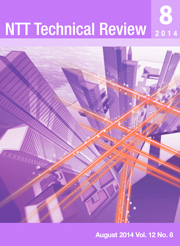
You need Adobe Reader 7.0 or later in order to read PDF files on this site.
If Adobe Reader is not installed on your computer, click the button below and go to the download site.

|
August 2014 Vol. 12 No. 8 |
|

Feature Articles: Technological Development for Network Virtualization-
 Current Status of Development of Network Virtualization Technologies Current Status of Development of Network Virtualization Technologies

Abstract
NTT laboratories have been active in researching and developing network virtualization technology as a key technology of future networks, which will be next-generation carrier networks. In this article, we outline the carrier network architecture, focusing specifically on the network virtualization technology implemented in it. We also introduce the research on elemental technologies being conducted by NTT laboratories.
-
 Service Function Chaining Technology for Future Networks Service Function Chaining Technology for Future Networks

Abstract
Service function chaining enables various network functions to be used rapidly and flexibly. This article describes methods of implementing service function chaining technology and also presents use cases.
-
 Network Virtualization Technology for Implementing Future Networks Network Virtualization Technology for Implementing Future Networks

Abstract
NTT Network Service Systems Laboratories has been applying network virtualization technologies such as NFV (network functions virtualisation) and SDN (software-defined networking) as part of efforts to develop the architecture of future networks that are efficient, flexible, and intelligent. This article gives an overview of these efforts.
-
 Ryu SDN Framework°ĹOpen-source SDN Platform Software Ryu SDN Framework°ĹOpen-source SDN Platform Software

Abstract
We introduce Ryu SDN Framework, an open source software (OSS) system developed by NTT, and describe our efforts toward promoting its wider adoption. Ryu SDN Framework is a platform that provides tools and libraries for easy use of SDN (software-defined networking). We have taken advantage of the strengths of OSS in developing Ryu, which conforms to the most recent industry-driven OpenFlow specifications. Ryu is used by a variety of experts including SDN application developers, network device developers, and network service maintainers.
-
 Fundamental Research Activities on Network Virtualization Fundamental Research Activities on Network Virtualization

Abstract
NTT Network Innovation Laboratories has been conducting a great deal of research in the areas of network virtualization and software-defined networking (SDN). In this article, we describe Lagopus, a high-performance OpenFlow 1.3 capable SDN software switch from the O3 Project. We also briefly explain our research activities involving network virtualization.
Regular Articles-
 High-temperature Superconductivity without Doping°ĹSynthesis of Conceptually New Superconductors High-temperature Superconductivity without Doping°ĹSynthesis of Conceptually New Superconductors

Abstract
High-temperature superconductivity is commonly associated with cuprate superconductors as their superconducting transition temperatures are still highest among all of the superconducting materials. It is these cuprate superconductors that drive scientists to reveal the very mechanism of its superconductivity and to derive models capable of predicting new superconducting material systems. Cuprate superconductors are built up of copper-oxygen planes, sandwiched by rare-earth or alkaline-earth oxide layers. The copper-oxygen layers form infinitely long planes, and it is those planes where superconductivity takes place. In particular, the copper ions in those planes may have three distinct coordinations, i.e., octahedral, pyramidal, and square-planar. Quite generally, electronic states are a function of crystal structure, crystal symmetry, and the elements building up the crystal structures. Nevertheless, it has been widely assumed that the copper-oxygen planes are inherently insulating and superconductivity is induced by doping carriers into those copper-oxygen planes. Indeed, such an approach is suitable for the copper-oxygen layers with octahedral and pyramidal coordinated copper, where superconductivity is induced by hole doping. For cuprates with square-planar coordinated copper, however, we demonstrate here that elimination of defects by annealing is the key to inducing superconductivity and doping is not a prerequisite for the emergence of superconductivity.
Global Standardization Activities-
 Standardization Activities of oneM2M Standardization Activities of oneM2M

Abstract
Machine-to-machine (M2M) services have been developed independently in a diverse range of fields such as industrial machinery and logistics. Demand has been increasing recently for an expansion of the market by building a common M2M platform and using mutual exploitation of M2M data across different industries. In 2012, major regional standards development organizations of Europe, the United States, and Asia established a unified standardization body named °∆oneM2M°« for M2M-associated technologies. This article presents the current status and future activities of oneM2M.
Practical Field Information about Telecommunication Technologies-
 Fault Cases in an IP Phone Circuit Accommodating a PBX via a VoIP-GW Fault Cases in an IP Phone Circuit Accommodating a PBX via a VoIP-GW

Abstract
This article introduces fault cases in an Internet protocol (IP) phone circuit accommodating a PBX (private branch exchange) via a VoIP-GW (voice over IP gateway). This is the twenty-fourth of a bimonthly series on the theme of practical field information on telecommunication technologies. This month°«s contribution is from the Network Interface Engineering Group, Technical Assistance and Support Center, Maintenance and Service Operations Department, Network Business Headquarters, NTT EAST.
External Awards/Papers Published in Technical Journals and Conference Proceedings
|










